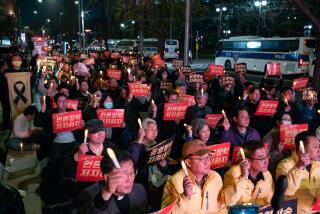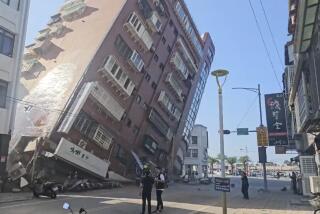City to Honor Sacrifices of Soviet Soldiers
Naum Sapozhnikov got his first taste of combat during the Battle of Stalingrad.
“It was the most terrible experience of my life,” Sapozhnikov said. “The Germans started to bomb. Everything was on fire. It was unbelievable.”
He was then just 22, eager to defend Mother Russia. In the end, he and his comrades prevailed. The battle marked a turning point in World War II, halting the Nazi offensive and destroying much of Hitler’s army. More than 1 million Soviets were killed or succumbed to disease or starvation.
The sacrifices of Sapozhnikov’s fallen comrades -- and of those who also somehow managed to survive -- will soon be recognized in West Hollywood, the artsy, eclectic city many former soldiers now call home.
The memorial -- a sloping triangular slab of red granite on a raised platform -- is scheduled to be installed this spring in West Hollywood’s Plummer Park, in the heart of the area’s Russian-speaking immigrant community.
West Hollywood officials said the monument is the first such tribute in the U.S. to veterans of a foreign army.
“It’s a symbol for a bright future,” said Yefim Stolyarskiy, 83, president of the Los Angeles Assn. of Veterans of WWII, which has 538 members. A lieutenant colonel from the former Soviet republic of Moldova, he served 30 years in the Red Army. “It’s a reminder of how people gave their lives for future generations.”
Stolyarskiy and other veterans gathered recently at Plummer Park to reminisce about the war and explain why such a monument was important for West Hollywood. Wearing a green army uniform decorated with 22 military medals and six government awards, Stolyarskiy said that though twice wounded during the war, his commitment to Russia never wavered.
“I wasn’t afraid of death,” said Stolyarskiy. “I felt a high duty to defend my native country.”
Now, he has a new country, and the monument demonstrates how the world has changed.
“Today, we have democracy and peace,” said Efim Kutz, a Ukrainian native, former army sergeant and a founding member of the veterans group, who emigrated from Kiev in 1977. “We hope that this monument will at some stage belong to the whole city.”
It will be unveiled May 8, a day before Victory Day, when the former Soviet Union officially observes the end of what Russians still call the Great Patriotic War. Russian-speakers comprise about 6,000 of West Hollywood’s 37,000 residents, according to city statistics. Most of them, like the aging veterans, are Jews who began immigrating to Los Angeles in the 1970s as refugees fleeing religious and political persecution.
The community has since blossomed into a thriving enclave with Russian-language bookstores, kosher shops and a hodgepodge of businesses sporting signs in the Cyrillic alphabet.
The veterans had been lobbying for a monument for the last eight years, Stolyarskiy said.
In 2001, City Councilman Jeffrey Prang introduced a proposal to donate a piece of land in Plummer Park, along with city administrative and logistical services, for the project. A citizens commission of community members and city officials solicited public submissions for the design of the structure and selected the winner.
A rendering by Mikhail Naruzetskiy, 74, a sculptor from Ukraine who came to West Hollywood in 1993, beat about a dozen other designs.
Rising to an 8-foot, 6-inch peak, the slanting 7-ton triangular mound will feature three white cranes and the engravings of four lines from a poem titled “Cranes” by Soviet poet Rasul Gamzatov. The poem became a much-loved song in Russia about World War II soldiers who never made it home.
The historical reality is sad, but the message is supposed to be uplifting, said Naruzetskiy, who designed several memorials in his home country.
“It’s meant to fit into the atmosphere of the park,” he said. “In Russia, we have sad monuments. Here, we have a park, and white birds are a joyous memory.”
Prang said the monument would cost around $100,000. Funding has come from private and business donations, along with contributions from the city of West Hollywood and Los Angeles County.
The Hollywood Forever Cemetery, where many movie stars are buried, agreed to build the monument, which was chiseled in India.
Cemetery President Tyler Cassity, whose company is subsidizing the cost of its work, said at least 10,000 Russian speakers are interred at Hollywood Forever. Planning for the monument was not without dispute.
One group of veterans felt some names should be engraved on the monument; others preferred leaving it blank.
“There was dissension and disagreement over the names themselves, and not everyone would be able to have their names on the monument,” Cassity recalled.
Hollywood Forever came up with a solution.
A bench and TV monitor will be mounted in front of the monument. Visitors will have access to a liquid-crystal touch-screen that will display a photo or video clip of old soldiers relating their life story on camera, or through a voice-over.
Natalie Parker, the cemetery’s documentary filmmaker, has collected about 5,000 oral histories from Russian speakers in the community, and many clips to be used at the monument will be drawn from that collection. Other interviews are still to be done.
But many community members initially viewed the film project with skepticism, wondering why the stories of ordinary soldiers would be of interest.
“A lot of people think their lives are just regular lives and their stories don’t need to be told,” said Parker, a native of Moscow, who came to the United States in 1991. “But each life is just a magnificent experience.”
Many of the veterans came to America as seniors, to join children who had settled in West Hollywood. “These are incredibly hearty people with amazing life histories, that demand to be heard and deserve to be heard,” Prang said.
“They survived the Holocaust. They survived the Nazi invasion of their country. They survived Josef Stalin, who was an anti-Semite. And they survived communism,” he said.
For Sapozhnikov, the war meant the loss of his family.
Many of Sapozhnikov’s relatives were killed at Babi Yar, a ravine in Kiev where the Nazis executed as many as 150,000 Jews and 50,000 others.
Now 86, the former aviation engineer wore an old uniform bedecked with medals as he described with military precision his time in the Soviet Air Force, which he left with the rank of lieutenant colonel.
“I served 27 years and three months,” he said.
Vladimir Barkon, 80, enlisted in the army at age 16. By 17, he found himself amid the carnage at Stalingrad, now called Volgograd. He survived a bout of typhus and was injured four times, incurring wounds to his head, leg and face from shrapnel and a grenade.
“I saw my uncle killed before my eyes,” he said.
Barkon, an army captain, proudly recalled how he helped liberate several countries across Europe and joyfully shook hands with American soldiers on the banks of the Elba River, as the allies met and rejoiced at the impending defeat of Nazi Germany.
As the number of Soviet veterans in West Hollywood declines -- 30 died last year -- many community elders are saddened that young people don’t know or appreciate the role their grandparents played during the war, or the global alliances that existed at that time.
“In America, youth don’t know that Russia, America and England collaborated in the war against fascism,” said Naruzetskiy, the sculptor.
“They should remember how much blood was spilled, how many lives were taken by the war,” Sapozhnikov said. “Many talented young people were killed.”
But Prang says the message behind the monument will speak to viewers of all ages and backgrounds. “Even though it’s about former Soviet veterans,” he said, “it’s about American citizens, American residents, American immigrants who have become part of the fabric of our community.... They are people who contributed to world peace and justice.”
More to Read
Start your day right
Sign up for Essential California for news, features and recommendations from the L.A. Times and beyond in your inbox six days a week.
You may occasionally receive promotional content from the Los Angeles Times.







